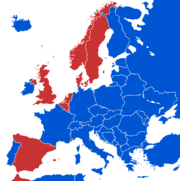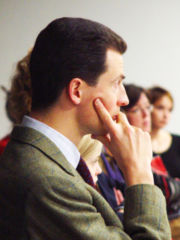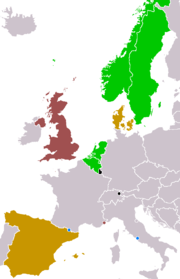Monarchies in Europe
2008/9 Schools Wikipedia Selection. Related subjects: Politics and government
There are twelve monarchies in Europe today, eleven of these are states whose head of state (a monarch) inherits his or her office, and usually keeps it for life or until they abdicate. The head of state in the State of the Vatican City, the pope, is elected at the papal conclave. At the dawn of the 20th century, France was the only major European nation to have a republican form of government. Among the smaller nations, Switzerland and San Marino held long republican traditions. The ascent of republicanism to the political mainstream only started at the beginning of the 20th century; as at the beginning of the 21st century, most of the states in the world, and in Europe, are republics (have a directly or indirectly elected head of state).
Europe's monarchies are:
- the
 Principality of Andorra
Principality of Andorra - the
 Kingdom of Belgium
Kingdom of Belgium - the
 Kingdom of Denmark
Kingdom of Denmark - the
 Principality of Liechtenstein
Principality of Liechtenstein - the
 Grand Duchy of Luxembourg
Grand Duchy of Luxembourg - the
 Principality of Monaco
Principality of Monaco - the
 Kingdom of the Netherlands
Kingdom of the Netherlands - the
 Kingdom of Norway
Kingdom of Norway - the
 Kingdom of Spain
Kingdom of Spain - the
 Kingdom of Sweden
Kingdom of Sweden - the
 United Kingdom of Great Britain and Northern Ireland
United Kingdom of Great Britain and Northern Ireland - the
 State of the Vatican City
State of the Vatican City
Most of the monarchies in Europe are constitutional monarchies, which means that the monarch does not influence the politics of the state: either the monarch is legally prohibited from doing so, or the monarch does not utilise the political powers vested in the office by convention. The exceptions are Liechtenstein, which is usually considered a semi-constitutional monarchy due to the large influence the prince still has on politics, and the Vatican City, which is a theocratic absolute elective monarchy. There is currently no major campaign to abolish the monarchy (see monarchism and republicanism) in any of the twelve states, although there is a significant minority of republicans in many of them (e. g. the political organisation Republic in the United Kingdom). Currently seven of the twelve monarchies are members of the European Union: Belgium, Denmark, Luxembourg, the Netherlands, Spain, Sweden and the United Kingdom.
Current monarchies
Belgium has been a kingdom since 21 July 1831 without interruption, after it became independent from the United Kingdom of the Netherlands with Léopold I as its first king. Belgium is the only remaining popular monarchy in the European Union: The monarch is formally known as the "King of the Belgians", not the "King of Belgium". While in a referendum held on 12 March 1950, 57.68 per cent of the Belgians voted in favour of allowing Léopold III, whose conduct during World War II had been considered questionable and who had been accused of treason, to return to the throne; due to civil unrest, however, he opted to abdicate in favour of his son Baudouin I on 16 July 1951. The current monarch is Albert II.
In Denmark, the monarchy goes back to the prehistoric times of the legendary kings, before the 10th century. Currently, about 80 per cent support keeping the monarchy. The current monarch is Margrethe II. The Danish monarchy also includes the Faroe Islands and Greenland which are parts of the Kingdom of Denmark with internal home rule. Due to this status, the monarch has no separate title for these regions.
Luxembourg has been an independent grand duchy since 9 June 1815. Originally, Luxembourg was in personal union with the United Kingdom of the Netherlands and the Kingdom of the Netherlands from 16 March 1815 until 23 November 1890. While Wilhelmina succeeded Willem III in the Netherlands, this was not possible in Luxembourg due to the order of succession being based on Salic law at that time; he was succeeded instead by Adolphe. In a referendum held on 28 September 1919, 80.34 per cent voted in favour of keeping the monarchy. The current monarch is Henri.
The Netherlands originally became independent as the Republic of the Seven United Netherlands, which lasted from 26 July 1581 until 18 January 1795, when the Netherlands became a French puppet state as the Batavian Republic. The Batavian Republic existed from 19 January 1795 until 4 June 1806. It was transformed into the Kingdom of Holland on 5 June 1806; since then, the Netherlands have been a kingdom. They were subsequently annexed to the French Empire in 1810. The United Kingdom of the Netherlands was established on 16 March 1815. With the independence of Belgium on 21 July 1831, the Netherlands again took a new form, as the Kingdom of the Netherlands. Nowadays, about 80 per cent of the Dutch are in favour of keeping the monarchy. The current monarch is Beatrix.
Norway was united and independent for the first time in the period around 1000– 1400. Norway was part of the Kalmar Union from 1397 until 1524, then part of Denmark–Norway from 1536 until 1814, and finally part of the Union between Sweden and Norway from 1814 until 1905. Norway became independent again on June 7, 1905. Support for establishing a republic lies around 20 per cent. The current monarch is Harald V.
Spain came into existence as a single, united kingdom under Carlos Ⅰ on 23 January 1516. The monarchy was briefly interrupted by the First Spanish Republic from 11 February 1873 until 29 December 1874. The monarchy was abolished again on 14 April 1931, first by the Second Spanish Republic — which lasted until 1 April 1939 — and subsequently by the dictatorship of Generalísimo Francisco Franco, who reigned until his death on 20 November 1975. Monarchy was restored on 22 November 1975 under Juan Carlos I, who is also the current monarch. Today, there is a large number of organisations campaigning in favour of establishing a Third Spanish Republic; however, only 25 per cent of Spaniards are in favour of establishing a republic.
Sweden and its monarchy goes back as far as the Danish one, to the semi–legendary kings before the 10th century, since when it has not been interrupted up to today. Nonetheless, it is not considered impossible that monarchy could be abolished in Sweden. The current monarch is Carl XVI Gustaf.
The monarchy of the United Kingdom of Great Britain and Northern Ireland can be defined to have started in either with the Kingdoms of England (871) or Scotland (843), with the Union of the Crowns on 24 March 1603, or with the Acts of Union of 1 May 1707. It was briefly interrupted by the English Interregnum, with the Commonwealth of England existing in its stead from 30 January 1649 until 15 December 1653 and from 26 May 1659 until 25 May 1660 and The Protectorate taking its place from 16 December 1653 until 25 May 1659. The current monarch is Elizabeth II.
Support for establishing a republic instead of a monarchy is around 20 per cent in the United Kingdom. While a majority thinks that there will still be monarchy in the United Kingdom ten years from now, public opinion is rather uncertain about a monarchy still existing in fifty years' time, and a clear majority believes that the monarchy will no longer exist a century from now. Public opinion is, however, certain that the monarchy will still exist in thirty years. About 30 per cent are in favour of discontinuing the monarchy after Elizabeth's death.
Commonwealth realms
The monarch of the United Kingdom is also the monarch of the fifteen other Commonwealth realms, all of which have varying levels of support for republicanism, most notably in:
- Australia: A referendum was held on the issue on 6 November 1999, which mostly failed due to the way the president would have been chosen under the provisions proposed. While long-time former Prime Minister John Howard was a monarchist, another attempt at establishing a republic will be made now that Kevin Rudd, who is a republican, replaced Howard as Prime Minister following the 2007 general election.
- Barbados: Prime Minister Owen Arthur called for a referendum on the issue to be held in 2005; the referendum had been pushed back to "at least 2006" in order to speed up Barbados' integration into the CARICOM Single Market and Economy; it was assumed the referendum would be held in 2007, but it was announced on 2007- 11-26 that the referendum would be held in 2008.
- Jamaica: (Now former) Prime Minister P. J. Patterson in 2003 called for Jamaica to become a republic by the end of his term in 2007; he has since been replaced by Portia Simpson-Miller and after the general election in 2007 by Bruce Golding, who has repeated that Jamaica would become a republic very soon, as had been expected before the election.
- Solomon Islands: The country has been working on a new constitution for several years now, and a constitutional convention is expected to finish their work in October 2008. The draft from 2004 declared the Solomon Islands a republic, and it is expected that this change will be part of the final new constitution.
- Tuvalu: (Now former) Prime Minister Saufatu Sopoanga had stated in 2004 that he was in favour of replacing the Queen as Tuvalu's head of state, a view supported by popular former Prime Minister Ionatana Ionatana; Sopoanga also stated that public opinion would be evaluated first before taking any further moves, however, no action has been taken since then. He has since been replaced by Apisai Ielemia.
- Canada and New Zealand, where the debate on republicanism is currently a secondary issue.
European microstates
Andorra has been a co-principality since the signing of a paréage in 1278, when the count of Foix and the bishop of La Seu d'Urgell agreed to share sovereignty over the landlocked country. After the title of the count of Foix had been passed to the kings of Navarre, and after Henry of Navarre had become Henry IV of France, an edict was issued in 1607 which established the French head of state as the legal successor to the count of Foix in regard to the paréage. Andorra was annexed by the First French Empire together with Catalonia in 1812–1813. After the Empire's demise, Andorra became independent again. The current monarchs are Joan Enric Vives Sicília and Nicolas Sarkozy.
Liechtenstein formally came into existence on 23 January 1719, when Charles VI, Holy Roman Emperor decreed the lordship of Schellenberg and the countship of Vaduz united and raised to the dignity of a principality. Liechtenstein was a part of the Holy Roman Empire until the Treaty of Pressburg was signed on 26 December 1805; this marked Liechtenstein's formal independence, though it was a member of the Confederation of the Rhine and the German Confederation afterwards. While Liechtenstein was still closely aligned with Austria-Hungary until World War I, it realigned its politics and its customs and monetary institutions with Switzerland instead. Having been a constitutional monarchy since 1921, Hans Adam II demanded more influence in Liechtenstein's politics in the early 21st century, which he was granted in a referendum held on 16 March 2003, effectively making Liechtenstein a semi-constitutional monarchy again. However, the constitutional changes also provide for the possibility of a referendum to abolish the monarchy entirely. The current monarch is Hans-Adam II.
Monaco has been ruled by the House of Grimaldi since 1297. From 1793 until 1814, Monaco was under French control; the Congress of Vienna designated Monaco as being a protectorate of the Kingdom of Sardinia from 1815 until 1860, when the Treaty of Turin ceded the surrounding counties of Nice and Savoy to France. Menton and Roquebrune-Cap-Martin, part of Monaco until the mid-19th century before seceding in hopes of being annexed by Sardinia, were ceded to France in exchange for 4,000,000 French francs with the Franco-Monegasque Treaty in 1861, which also formally guaranteed Monaco its independence. Until 2002, Monaco would have become part of France had the house of Grimaldi ever died out; in a treaty signed that year, the two nations agreed that Monaco would remain independent even in such a case. The current monarch is Albert II.
The Vatican City became independent from Italy through the Lateran Treaty of 1929. Since then, the pope is the elected monarch of the city-state. The current monarch is Benedict XVI.
Succession laws
The succession order is determined by primogeniture in most European monarchies. Belgium, the Netherlands, Norway and Sweden adhere to equal primogeniture, whereby the eldest child inherits the throne, regardless of gender; Denmark, Monaco, Spain and the United Kingdom still have the older system of male primogeniture, whereby sons have precedence over daughters in the order of succession. There are plans to change this in Denmark and Spain through rather complicated processes, as the change entails constitutional amendments.
In Denmark, the parliament elected in 2005 has already passed the law. After the next election on November 13, 2007, the next parliament will have to pass the law again, whereafter it has to be confirmed in a referendum in which at least 40 per cent of all potential voters will have to support the change for it to take place. Likewise, in Spain two successive parliaments will have to pass the law by a two-thirds majority and then put it to a referendum. As parliament has to be dissolved and new elections have to be called after the constitutional amendment is passed for the first time, the current Presidente del Gobierno José Luis Rodríguez Zapatero has indicated he will wait until the end of his current term in 2008 before passing the law. The amendment enjoys strong public support.
There have also been suggestions to change the order of succession in the United Kingdom; however, as the Queen of the United Kingdom is also the Queen of the fifteen other Commonwealth realms who have independent regulations regarding the order of succession, a change would have to be made simultaneously in all of the Commonwealth realms to continue the current personal union, and since the need for change is not imminent yet (as Charles will succeed his mother Elizabeth II, and Charles' oldest son William will succeed him in turn, with no older sisters who would be skipped under the current male primogeniture laws), the change has been postponed to a later time.
Liechtenstein and Luxembourg have an even older system of succession (agnatic primogeniture/Salic law), which completely excludes women from the order of succession unless there are no male heirs of any kind present, and the monarchs of Andorra and the Vatican City are elected (the president of the French Republic and the pope) and appointed (the bishop of La Sea d'Urgell). Liechtenstein was criticised for this by a United Nations committee for gender equality in November 2007.
Table of monarchies in Europe
| State | Type | Succession | Incumbent | Born | Age | Reigns since | Successor |
|---|---|---|---|---|---|---|---|
| co-principality | special case: two co-princes |
J. E. Vives i Sicília ( Bishop of Urgell) |
24 Jul 1949 | 58 y. | 12 May 2003 | to be appointed by the pope | |
| Nicolas Sarkozy ( President of France) |
28 Jan 1955 | 53 y. | 17 May 2007 | to be elected in 2012 | |||
| kingdom | equal primogeniture | Albert II | 6 Jun 1934 | 74 y. | 9 Aug 1993 | Philippe (I) | |
| kingdom | male primogeniture (equal primog. planned) |
Margrethe II | 16 Apr 1940 | 68 y. | 14 Jan 1972 | Frederik (X) | |
| principality | agnatic primogeniture | Hans-Adam II | 14 Feb 1945 | 63 y. | 13 Nov 1989 | Alois (III) | |
| grand duchy | agnatic primogeniture | Henri I | 16 Apr 1955 | 53 y. | 7 Oct 2000 | Guillaume (V) | |
| principality | male primogeniture | Albert II | 14 Mar 1958 | 50 y. | 6 Apr 2005 | Caroline (I) (sister) | |
| kingdom | equal primogeniture | Beatrix I | 31 Jan 1938 | 70 y. | 30 Apr 1980 | Willem (IV) | |
| kingdom | equal primogeniture | Harald V | 21 Feb 1937 | 71 y. | 17 Jan 1991 | Haakon (VIII) | |
| kingdom | male primogeniture (equal primog. planned) |
Juan Carlos I | 5 Jan 1938 | 70 y. | 22 Nov 1975 | Felipe (VI) | |
| kingdom | equal primogeniture | Carl XVI Gustaf | 30 Apr 1946 | 62 y. | 15 Sep 1973 | Victoria (I) | |
| kingdom | male primogeniture (equal primog. considered) |
Elizabeth II | 21 Apr 1926 | 82 y. | 6 Feb 1952 | Charles (III) | |
| theocracy | elective monarchy | Benedictus XVI | 16 Apr 1927 | 81 y. | 19 Apr 2005 | to be elected in Papal conclave | |
| I^ Caroline is, as the ruling prince's eldest sister, the current Heiress Presumptive and therefore, following Monegasque tradition, also Heiress Apparent; should Albert II father legitimate children, however, they would be first in line to succeed him instead of Caroline. II^ The monarch of the United Kingdom is also the sovereign of the fifteen other Commonwealth realms: III^ While Charles would be the third kind of his name to sit on the British throne, it has also been suggested that he will choose George VII as his regnal name instead in light of the unpopularity of Charles I and Charles II. |
|||||||





